 W
WSewerage is the infrastructure that conveys sewage or surface runoff using sewers. It encompasses components such as receiving drains, manholes, pumping stations, storm overflows, and screening chambers of the combined sewer or sanitary sewer. Sewerage ends at the entry to a sewage treatment plant or at the point of discharge into the environment. It is the system of pipes, chambers, manholes, etc. that conveys the sewage or storm water.
 W
WThe activated sludge process is a type of wastewater treatment process for treating sewage or industrial wastewaters using aeration and a biological floc composed of bacteria and protozoa.
 W
WThe biological treatment of wastewater in the sewage treatment plant is often accomplished using conventional activated sludge systems. These systems generally require large surface areas for treatment and biomass separation units due to the generally poor settling properties of the sludge. Aerobic granules are a type of sludge that can self-immobilize flocs and microorganisms into spherical and strong compact structures. The advantages of aerobic granular sludge are excellent settleability, high biomass retention, simultaneous nutrient removal and tolerance to toxicity. Recent studies show that aerobic granular sludge treatment could be a potentially good method to treat high strength wastewaters with nutrients, toxic substances.
 W
WSewer alligator stories date back to the late 1920s and early 1930s; in most instances they are part of contemporary legend. They are based upon reports of alligator sightings in rather unorthodox locations, in particular New York City. The New York Times reports the city rescues several alligators per year, some directly from homes where they are kept as illegal pets, and some from outside though mostly above-ground. Though escapees and former pets may survive for a short time in New York sewers, longer-term survival is not possible due to low temperatures and the bacteria in human feces. Sewer maintenance crews insist there is no underground population.
 W
WAnaerobic digestion is a sequence of processes by which microorganisms break down biodegradable material in the absence of oxygen. The process is used for industrial or domestic purposes to manage waste or to produce fuels. Much of the fermentation used industrially to produce food and drink products, as well as home fermentation, uses anaerobic digestion.
 W
WAnthroponics is a type of hydroponics system that uses human waste like urine as the source of nutrients for the cultivated plants. In general, the human urine or mixed waste is collected and stored for a period of time, before being applied either directly or passed through a biofilter before reaching the plants. As a form of organic hydroponics, anthroponics combines elements of both hydroponics and aquaponics systems.
 W
WAquaver is a cleantech company headquartered in Voorburg, Netherlands, with offices at the High Tech Campus Eindhoven. Aquaver is acknowledged to be the first company worldwide to develop commercial systems based on membrane distillation, a novel technology for water treatment.
 W
WBiosolids are solid organic matter recovered from a sewage treatment process and used as fertilizer. In the past, it was common for farmers to use animal manure to improve their soil fertility. In the 1920s, the farming community began also to use sewage sludge from local wastewater treatment plants. Scientific research over many years has confirmed that these biosolids contain similar nutrients to those in animal manures. Biosolids that are used as fertilizer in the farming community are usually treated to help to prevent disease-causing pathogens from spreading to the public.
 W
WA cesspit, is a term with various meanings: it is used to describe either an underground holding tank or a soak pit. It can be used for the temporary collection and storage of feces, excreta or fecal sludge as part of an on-site sanitation system and has some similarities with septic tanks or with soak pits. Traditionally, it was a deep cylindrical chamber dug into the ground, having approximate dimensions of 1 metre diameter and 2–3 metres depth. Their appearance was similar to that of a hand-dug water well.
 W
WClarifiers are settling tanks built with mechanical means for continuous removal of solids being deposited by sedimentation. A clarifier is generally used to remove solid particulates or suspended solids from liquid for clarification and/or thickening. Concentrated impurities, discharged from the bottom of the tank are known as sludge, while the particles that float to the surface of the liquid are called scum.
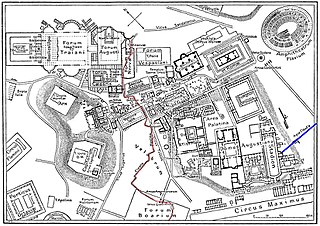 W
WThe Cloaca Maxima was one of the world's earliest sewage systems. Constructed in Ancient Rome in order to drain local marshes and remove the waste of one of the world's most populous cities, it carried effluent to the River Tiber, which ran beside the city.
 W
WThe sewerage system of Cologne is part of the water infrastructure serving Cologne, Germany. Originally built by the Roman Empire in the 1st century, the city's sewer system was modernised in the late 19th century. Parts of the subterranean network are opened for public tours, and the unusual Chandelier Hall hosts jazz and classical music performances.
 W
WCommunity-led total sanitation (CLTS) is an approach used mainly in developing countries to improve sanitation and hygiene practices in a community. The approach tries to achieve behavior change in mainly rural people by a process of "triggering", leading to spontaneous and long-term abandonment of open defecation practices. It focuses on spontaneous and long-lasting behavior change of an entire community. The term "triggering" is central to the CLTS process: It refers to ways of igniting community interest in ending open defecation, usually by building simple toilets, such as pit latrines. CLTS involves actions leading to increased self-respect and pride in one's community. It also involves shame and disgust about one's own open defecation behaviors. CLTS takes an approach to rural sanitation that works without hardware subsidies and that facilitates communities to recognize the problem of open defecation and take collective action to clean up and become "open defecation free".
 W
WCondrain Group, stylized as Condrain, is a sewer and watermain contractor in North America.
 W
WA dry well or drywell is an underground structure that disposes of unwanted water, most commonly surface runoff and stormwater and in some cases greywater. It is a covered, porous-walled chamber that allows water to slowly soak into the ground, dissipating into the groundwater. Such structures are often called a soakaway in the United Kingdom, a soakwell in Australia, and a soak pit in India.
 W
WEcological sanitation, commonly abbreviated as ecosan, is an approach to sanitation provision which aims to safely reuse excreta in agriculture. It is an approach, rather than a technology or a device which is characterized by a desire to "close the loop", mainly for the nutrients and organic matter between sanitation and agriculture in a safe manner. One of the aims is to minimise the use of non-renewable resources. When properly designed and operated, ecosan systems provide a hygienically safe system to convert human excreta into nutrients to be returned to the soil, and water to be returned to the land. Ecosan is also called resource-oriented sanitation.
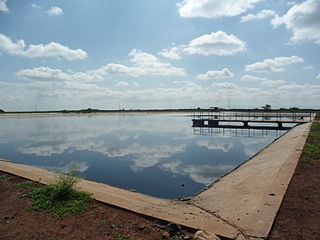 W
WFacultative lagoons are a type of waste stabilization pond used for biological treatment of industrial and domestic wastewater. Sewage or organic waste from food or fiber processing may be catabolized in a system of constructed ponds where adequate space is available to provide an average waste retention time exceeding a month. A series of ponds prevents mixing of untreated waste with treated wastewater and allows better control of waste residence time for uniform treatment efficiency.
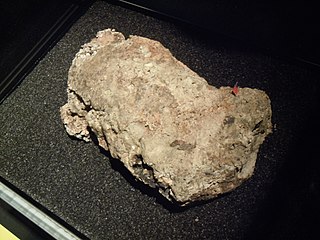 W
WA fatberg is a rock-like mass of waste matter in a sewer system formed by the combination of flushed non-biodegradable solids, such as wet wipes, and congealed grease or cooking fat. Fatbergs have occurred in cities and towns worldwide, with the rise in usage of disposable cloths. Several prominent examples were discovered in the 2010s in Great Britain, their formation accelerated by ageing Victorian sewers. Fatbergs are costly to remove, and have given rise to public awareness campaigns about flushable waste.
 W
WFecal sludge management (FSM) is the collection, transport, and treatment of fecal sludge from pit latrines, septic tanks or other onsite sanitation systems. Fecal sludge is a mixture of human excreta, water and solid wastes that are disposed of in pits, tanks or vaults of onsite sanitation systems. Fecal sludge that is removed from septic tanks is called septage.
 W
WFine bubble diffusers are a pollution control technology used to aerate wastewater for sewage treatment.
 W
WA French drain or weeping tile is a trench filled with gravel or rock or containing a perforated pipe that redirects surface water and groundwater away from an area.
 W
WThe Great Stink was an event in Central London in July and August 1858 during which the hot weather exacerbated the smell of untreated human waste and industrial effluent that was present on the banks of the River Thames. The problem had been mounting for some years, with an ageing and inadequate sewer system that emptied directly into the Thames. The miasma from the effluent was thought to transmit contagious diseases, and three outbreaks of cholera before the Great Stink were blamed on the ongoing problems with the river.
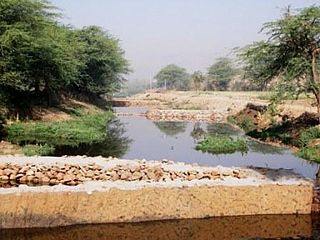 W
WGreen bridges are an ecotechnological in-situ bio remediation system. Their different physical and biological filters work in combination to remove suspended and dissolved impurities of water. Green bridge filters help in reducing the suspended solids by filtration process, reducing Chemical Oxygen Demand (COD)/Biochemical Oxygen Demand (BOD) by aerobic degradation. Green Bridges also help in the restoration of ecological food chain.
 W
WLiving Machine is a form of ecological sewage treatment. Similar to Solar Aquatics Systems, the latest generation of the technology is based on fixed-film ecology.
 W
WThe London sewerage system is part of the water infrastructure serving London, England. The modern system was developed during the late 19th century, and as London has grown the system has been expanded. It is currently owned and operated by Thames Water and serves almost all of Greater London.
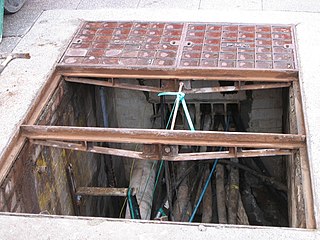 W
WA manhole is an opening to a confined space such as a shaft, utility vault, or large vessel. Manholes are often used as an access point for an underground public utility, allowing inspection, maintenance, and system upgrades. The majority of underground services have manholes, including water, sewers, telephone, electricity, storm drains, district heating, and gas.
 W
WMoving bed biofilm reactor (MBBR) is a type of wastewater treatment process that was first invented by Prof. Hallvard Ødegaard at Norwegian University of Science and Technology in the late 1980s. It was commercialized by Kaldnes Miljöteknologi. There are over 700 wastewater treatment systems installed in over 50 countries. Currently, there are various suppliers of MBBR systems.
 W
WNereda is a wastewater treatment technology invented by Mark van Loosdrecht of the Delft University of Technology in the Netherlands. The technology is based on aerobic granulation and is a modification of the activated sludge process.
 W
WMost organisms involved in water purification originate from the waste, wastewater or water stream itself or arrive as resting spore of some form from the atmosphere. In a very few cases, mostly associated with constructed wetlands, specific organisms are planted to maximise the efficiency of the process.
 W
WPackaged metering manholes (PMMs) are an outgrowth of the fiberglass manholes developed in the 1960s. Packaged metering manhole factories integrate a primary device into a fiberglass manhole.
 W
WA plug in sanitation is an object that is used to close a drainage outlet firmly.
 W
WSanitary sewer overflow (SSO) is a condition in which untreated sewage is discharged from a sanitary sewer into the environment prior to reaching sewage treatment facilities. When caused by rainfall it is also known as wet weather overflow. It is primarily meaningful in developed countries, which have extensive treatment facilities. Frequent causes of SSO spills include:Blockage of sewer lines Infiltration/Inflow of excessive stormwater into sewer lines during heavy rainfall Malfunction of pumping station lifts or electrical power failure Broken sewer lines.
 W
WSanitation refers to public health conditions related to clean drinking water and adequate treatment and disposal of human excreta and sewage. Preventing human contact with feces is part of sanitation, as is hand washing with soap. Sanitation systems aim to protect human health by providing a clean environment that will stop the transmission of disease, especially through the fecal–oral route. For example, diarrhea, a main cause of malnutrition and stunted growth in children, can be reduced through adequate sanitation. There are many other diseases which are easily transmitted in communities that have low levels of sanitation, such as ascariasis, cholera, hepatitis, polio, schistosomiasis, and trachoma, to name just a few.
 W
WSecondary treatment is a treatment process for wastewater to achieve a certain degree of effluent quality by using a sewage treatment plant with physical phase separation to remove settleable solids and a biological process to remove dissolved and suspended organic compounds. After this kind of treatment, the wastewater may be called as secondary-treated wastewater.
 W
WFecal sludge management (FSM) is the collection, transport, and treatment of fecal sludge from pit latrines, septic tanks or other onsite sanitation systems. Fecal sludge is a mixture of human excreta, water and solid wastes that are disposed of in pits, tanks or vaults of onsite sanitation systems. Fecal sludge that is removed from septic tanks is called septage.
Septic drain fields, also called leach fields or leach drains, are subsurface wastewater disposal facilities used to remove contaminants and impurities from the liquid that emerges after anaerobic digestion in a septic tank. Organic materials in the liquid are catabolized by a microbial ecosystem.
 W
WSewage, or domestic/municipal wastewater, is a type of wastewater that is produced by a community of people. It is characterized by volume or rate of flow, physical condition, chemical and toxic constituents, and its bacteriologic status. It consists mostly of greywater, blackwater ; soaps and detergents; and toilet paper.
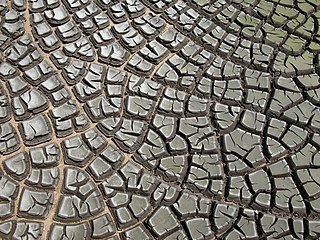 W
WSewage sludge is the residual, semi-solid material that is produced as a by-product during sewage treatment of industrial or municipal wastewater. The term "septage" also refers to sludge from simple wastewater treatment but is connected to simple on-site sanitation systems, such as septic tanks.
 W
WSewage sludge treatment describes the processes used to manage and dispose of sewage sludge produced during sewage treatment. Sludge is mostly water with lesser amounts of solid material removed from liquid sewage. Primary sludge includes settleable solids removed during primary treatment in primary clarifiers. Secondary sludge separated in secondary clarifiers includes treated sewage sludge from secondary treatment bioreactors.
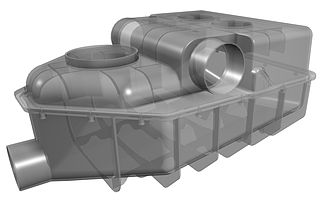 W
WA sewer dosing unit (SDU) is a plumbing device to allow effective sewage disposal with low liquid-flow rates. With a global emphasis on water saving, many new buildings and renovations are seeing the installation of water saving fixtures such as low flow shower heads and low flush toilets. With the decrease in wastewater flows problems are arising from waste solids not being carried completely to the main sewers, often causing blockages.
 W
WThe Sewer Murders or "Sewage Plant Murders" were an unexplained murder series of male adolescents in the Frankfurt Rhine-Main area during the 1970s and 1980s.
 W
WThe Paris Sewer Museum, is a museum located in the sewers at the esplanade Habib-Bourguiba, near the pont de l'Alma, in the 7th arrondissement of Paris, France. It is closed for renovation and to allow its accessibily to the disabled from July 2, 2018 until end-2020.
 W
WSimplified sewerage, also called small-bore sewerage, is a sewer system that collects all household wastewater in small-diameter pipes laid at fairly flat gradients. Simplified sewers are laid in the front yard or under the pavement (sidewalk) or - if feasible - inside the back yard, rather than in the centre of the road as with conventional sewerage. It is suitable for existing unplanned low-income areas, as well as new housing estates with a regular layout. It allows for a more flexible design. With simplified sewerage it is crucial to have management arrangements in place to remove blockages, which are more frequent than with conventional sewers. It has been estimated that simplified sewerage reduces investment costs by up to 50% compared to conventional sewerage.
 W
WSludge is a semi-solid slurry that can be produced from a range of industrial processes, from water treatment, wastewater treatment or on-site sanitation systems. For example, it can be produced as a settled suspension obtained from conventional drinking water treatment, as sewage sludge from wastewater treatment processes or as fecal sludge from pit latrines and septic tanks. The term is also sometimes used as a generic term for solids separated from suspension in a liquid; this 'soupy' material usually contains significant quantities of 'interstitial' water. Sludge can consist of a variety of particles, such as animal manure.
 W
WA submersible mixer is a mechanical device that is used to mix sludge tanks and other liquid volumes. Submersible mixers are often used in sewage treatment plants to keep solids in suspension in the various process tanks and/or sludge holding tanks.
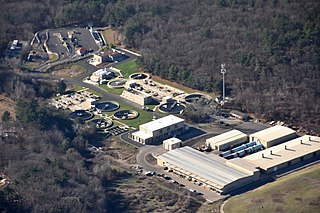 W
WSewage treatment is the process of removing contaminants from municipal wastewater, containing mainly household sewage plus some industrial wastewater. Physical, chemical, and biological processes are used to remove contaminants and produce treated wastewater that is safe enough for release into the environment. A by-product of sewage treatment is a semi-solid waste or slurry, called sewage sludge. The sludge has to undergo further treatment before being suitable for disposal or application to land.
 W
WThermal hydrolysis is a process used for treating industrial waste, municipal solid waste and sewage sludge.
 W
WSewage treatment is the process of removing contaminants from municipal wastewater, containing mainly household sewage plus some industrial wastewater. Physical, chemical, and biological processes are used to remove contaminants and produce treated wastewater that is safe enough for release into the environment. A by-product of sewage treatment is a semi-solid waste or slurry, called sewage sludge. The sludge has to undergo further treatment before being suitable for disposal or application to land.
 W
WA trickling filter is a type of wastewater treatment system. It consists of a fixed bed of rocks, coke, gravel, slag, polyurethane foam, sphagnum peat moss, ceramic, or plastic media over which sewage or other wastewater flows downward and causes a layer of microbial slime (biofilm) to grow, covering the bed of media. Aerobic conditions are maintained by splashing, diffusion, and either by forced-air flowing through the bed or natural convection of air if the filter medium is porous.
 W
WThe Urban Waste Water Treatment Directive is a 1991 European Union directive concerning urban waste water "collection, treatment and discharge of urban waste water and the treatment and discharge of waste water from certain industrial sectors". It aims "to protect the environment from adverse effects of waste water discharges from cities and "certain industrial sectors".
 W
WUrine diversion, also called urine separation or source separation, refers to the separate collection of human urine and feces at the point of their production, i.e. at the toilet or urinal. Separation of urine from feces allows human waste to be treated separately and used as a potential resource. Applications are typically found where connection to a sewer-based sanitation system is not available or areas where water supplies are limited.
 W
WVitrified clay pipe (VCP) is pipe made from a blend of clay and shale that has been subjected to high temperature to achieve vitrification, which results in a hard, inert ceramic.
 W
WWastewater is any water that has been contaminated by human use. Wastewater is "used water from any combination of domestic, industrial, commercial or agricultural activities, surface runoff or stormwater, and any sewer inflow or sewer infiltration". Therefore, wastewater is a byproduct of domestic, industrial, commercial or agricultural activities. The characteristics of wastewater vary depending on the source. Types of wastewater include: domestic wastewater from households, municipal wastewater from communities and industrial wastewater. Wastewater can contain physical, chemical and biological pollutants.
 W
WThe water industry provides drinking water and wastewater services to residential, commercial, and industrial sectors of the economy. Typically public utilities operate water supply networks. The water industry does not include manufacturers and suppliers of bottled water, which is part of the beverage production and belongs to the food sector.
 W
WWater resource policy encompasses the policy-making processes that affect the collection, preparation, use and disposal of water to support human uses and protect environmental quality. Water policy addresses provision, use, disposal and sustainability decisions. Provision includes identification, access, preparation for use and distribution. Uses include direct human consumption, agriculture, industry and ecosystem protection. Policy must set the rules for how water is allocated to the different uses. Disposal involves wastewater treatment and stormwater/flood management. Sustainability addresses issues such as aquifer depletion, reservoir management and mineral buildup.